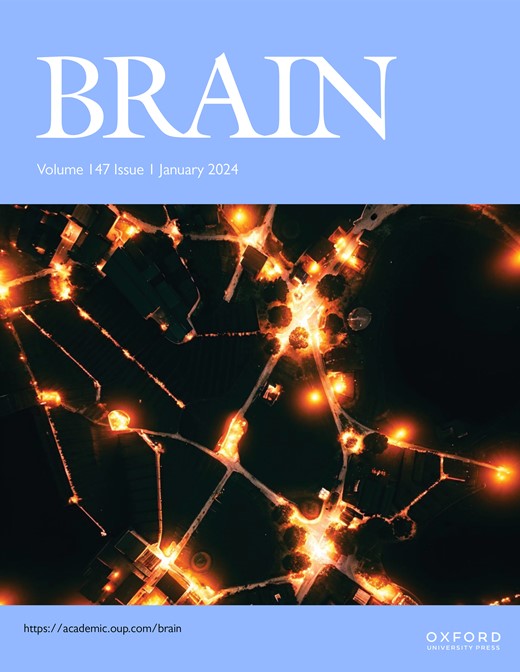Aberrant lysosomal dynamics disrupt myogenesis via mTORC1 signalling in X-linked myotubular myopathy.
IF 11.7
1区 医学
Q1 CLINICAL NEUROLOGY
引用次数: 0
Abstract
X-linked myotubular myopathy is a severe congenital muscle disorder caused by pathogenic variants in the MTM1 gene, which encodes the phosphoinositide phosphatase myotubularin. Muscle biopsies from patients with X-linked myotubular myopathy exhibit distinctive histopathological features, including small, rounded myofibres with centrally located nuclei, indicating a developmental defect in muscle maturation. While earlier studies have indicated that myotubularin dysfunction causes dysregulation of mechanistic target of rapamycin complex 1 (mTORC1) signalling, the underlying mechanisms and phenotypic impact on human muscle cells remain poorly understood. Currently, there are no approved therapies available for the treatment of this disorder. In this study, we established an induced pluripotent stem cell-based model of X-linked myotubular myopathy using two pairs of isogenic induced pluripotent stem cells: healthy-control versus MTM1-knockout and patient-derived versus gene-corrected induced pluripotent stem cells. Through MyoD-inducible myogenic differentiation, this model successfully recapitulates the key pathological features of X-linked myotubular myopathy, including elevated phosphatidylinositol-3-phosphate levels, hyperactivation of mTORC1 signalling, and increased expression of integrin-β1 and dynamin 2. We identified impaired lysosomal dynamics as a novel pathogenic mechanism in X-linked myotubular myopathy. Our induced pluripotent stem cell-derived X-linked myotubular myopathy myotubes exhibited an abnormal redistribution of lysosomes, with peripheral accumulation, leading to abnormally activated mTORC1 signalling. FYCO1 knockdown, a key regulator of lysosomal trafficking, ameliorated this hyperactivation of mTORC1 signalling. Comprehensive transcriptome analysis revealed distinct gene expression patterns associated with altered mTORC1 signalling and lysosomal localisation in X-linked myotubular myopathy myotubes. Network analysis suggested the central role of the mTORC1 signalling pathway and its connections to disrupted muscle development and differentiation. To investigate the influence of mTORC1 signalling and myotubularin deficiency on myogenic differentiation, we established two mouse myoblast models: one with constitutively activated mTORC1 signalling and another with Mtm1 knockout. Increased mTORC1 signalling in mouse myoblasts impaired myogenic differentiation, and this impairment was reversed by mTORC1 inhibitor rapamycin. Notably, rapamycin treatment also ameliorated the impaired myogenic differentiation observed in Mtm1-knockout mouse myoblasts, supporting the causative role of mTORC1 hyperactivation in X-linked myotubular myopathy pathogenesis. In conclusion, our findings establish the first human cell model of XLMTM, revealing that myotubularin deficiency leads to impaired lysosomal dynamics, which in turn causes mTORC1 dysregulation, a critical factor in the early stage of myogenic differentiation in X-linked myotubular myopathy. These findings provide new insights into the pathogenesis of X-linked myotubular myopathy and suggest that targeting mTORC1 signalling may be a promising therapeutic strategy for this debilitating disorder.异常溶酶体动力学通过mTORC1信号在x连锁肌小管肌病中破坏肌肉发生。
x连锁肌小管肌病是一种由MTM1基因致病性变异引起的严重先天性肌肉疾病,MTM1基因编码肌小管蛋白磷酸肌苷磷酸酶。x连锁肌小管肌病患者的肌肉活检显示出独特的组织病理学特征,包括小而圆的肌纤维,核位于中央,表明肌肉成熟过程中存在发育缺陷。虽然早期的研究表明,肌管蛋白功能障碍导致雷帕霉素复合物1 (mTORC1)信号传导的机制靶点失调,但其潜在机制和对人类肌肉细胞的表型影响仍然知之甚少。目前,还没有批准的治疗这种疾病的方法。在这项研究中,我们使用两对等基因诱导多能干细胞建立了一个基于诱导多能干细胞的x连锁肌小管肌病模型:健康对照与mtm1敲除,患者来源与基因校正的诱导多能干细胞。通过myord诱导的肌源性分化,该模型成功概括了x连锁肌小管肌病的关键病理特征,包括磷脂酰肌醇-3-磷酸水平升高、mTORC1信号的过度激活、整合素-β1和动力蛋白2的表达增加。我们发现溶酶体动力学受损是x连锁肌小管肌病的一种新的致病机制。我们的诱导多能干细胞衍生的x连锁肌小管肌病肌管表现出溶酶体的异常重新分布,并伴有外周积聚,导致mTORC1信号异常激活。FYCO1敲低是溶酶体运输的关键调节因子,改善了mTORC1信号的这种过度激活。综合转录组分析揭示了x连锁肌小管肌病中与mTORC1信号和溶酶体定位改变相关的不同基因表达模式。网络分析表明mTORC1信号通路的核心作用及其与肌肉发育和分化中断的联系。为了研究mTORC1信号和肌小管蛋白缺乏对成肌分化的影响,我们建立了两种小鼠成肌细胞模型:一种是mTORC1信号组成激活的模型,另一种是Mtm1敲除的模型。小鼠成肌细胞中mTORC1信号的增加会损害成肌细胞的分化,而mTORC1抑制剂雷帕霉素可以逆转这种损害。值得注意的是,雷帕霉素治疗还改善了mtm1敲除小鼠成肌细胞中观察到的肌源性分化受损,支持了mTORC1过度激活在x连锁肌小管肌病发病机制中的致病作用。总之,我们的研究结果建立了第一个XLMTM的人类细胞模型,揭示了肌小管蛋白缺乏导致溶酶体动力学受损,进而导致mTORC1失调,这是x连锁肌小管肌病早期肌源性分化的关键因素。这些发现为x连锁肌小管肌病的发病机制提供了新的见解,并表明靶向mTORC1信号可能是治疗这种衰弱性疾病的一种有希望的治疗策略。
本文章由计算机程序翻译,如有差异,请以英文原文为准。
求助全文
约1分钟内获得全文
求助全文
来源期刊

Brain
医学-临床神经学
CiteScore
20.30
自引率
4.10%
发文量
458
审稿时长
3-6 weeks
期刊介绍:
Brain, a journal focused on clinical neurology and translational neuroscience, has been publishing landmark papers since 1878. The journal aims to expand its scope by including studies that shed light on disease mechanisms and conducting innovative clinical trials for brain disorders. With a wide range of topics covered, the Editorial Board represents the international readership and diverse coverage of the journal. Accepted articles are promptly posted online, typically within a few weeks of acceptance. As of 2022, Brain holds an impressive impact factor of 14.5, according to the Journal Citation Reports.
 求助内容:
求助内容: 应助结果提醒方式:
应助结果提醒方式:


